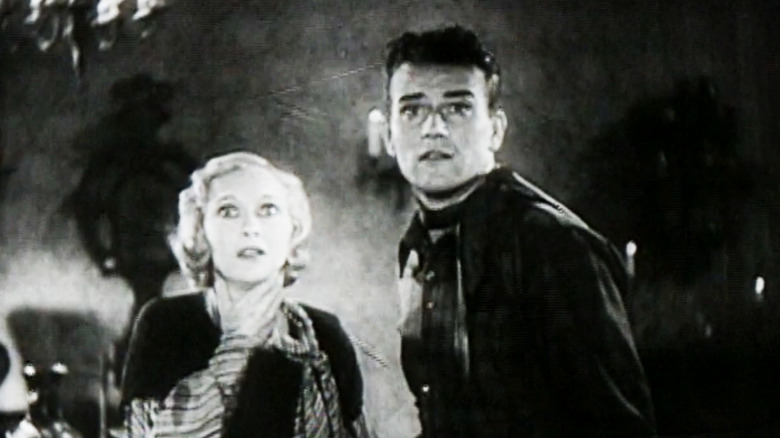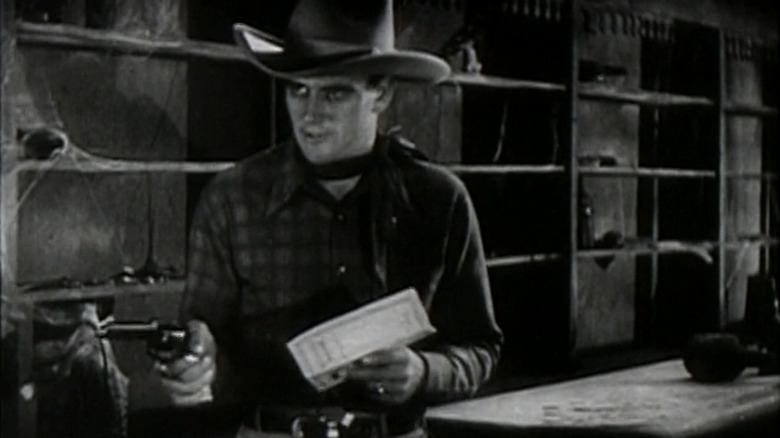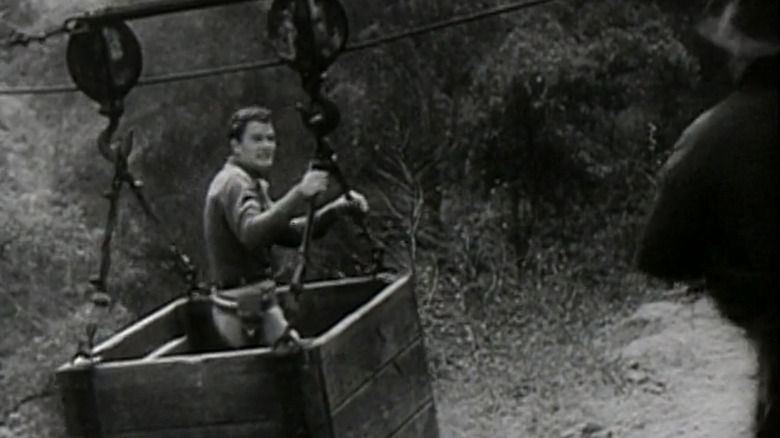
Though he made his share of clunkers throughout his career, John Wayne starred in some of his worst films early on. A big part of that was simply down to the way movies were made in the late 1920s and early '30s. Every fan of the Duke knows about his so-called "Poverty Row" era, where he fronted Western movies made for cheap and churned out at a dizzying rate. But when sound in film started to emerge in the late 1920s, Wayne also found himself leading some unique and curious movies that were all based
on pictures that had come out less than a decade prior.
For example, Wayne was cast in an early Western remake for the unusual reason that he resembled the star of the original movie. Indeed, Ken Maynard had fronted multiple features for First National Pictures during the '20s, including 1926's "The Unknown Cavalier." Once Warner Bros. bought the studio outright, however, producers Leon Schlesinger and Sid Rogell decided to remake several of Maynard's films as "talkies" (which essentially means they added sound). But these weren't full remakes. 1932's "Ride Him, Cowboy" was a retread of "The Unknown Cavalier" in which Wayne played the lead role, filling in for Maynard in the scenes where you can clearly see his face. But Warners actually re-used footage from the original movie for the action scenes.
This wasn't the first time the Duke had been used as a Maynard stand-in, either. Warners had previously enlisted the young actor for a remake of 1928's "The Phantom City," which the studio retitled "Haunted Gold." Aside from representing one of these curious talkie quasi-remakes, the film is notable for being the closest Wayne ever came to making a horror movie.
Read more: Every Taylor Sheridan Movie, Ranked From Worst To Best
Haunted Gold Was The Closest John Wayne Ever Got To Full-On Horror

Between 1932 and 1933, Warner Bros. produced six remakes of Ken Maynard Westerns with John Wayne in the lead role. 1932's "Haunted Gold" was the first (though it was released third). The film is a Western, a mystery, and, according to some (including The Movie Database), a horror film. "Spooks! Ghosts! And a fortune in gold" are all promised in the trailer for this remake of the Maynard-led 1928 silent Western "The Phantom City." Whether it really qualifies as a horror movie is debatable, but it was certainly the closest the Duke ever came to the genre.
In the film, directed by Mack V. Wright, Wayne plays John Mason, who receives a mysterious letter urging him to return to a mine to claim his share of the gold therein. Mason travels to the mine on his trusty steed, Duke, who actually received second billing on the film and appeared alongside Wayne in numerous other pictures. Once there, he meets Sheila Terry's Janet Carter, a miner's daughter who was also sent a letter and is there to claim her share of the treasure. Soon, outlaw Joe Ryan (Harry Woods) and his gang arrive with plans to take the gold for themselves, but the only thing more menacing than them is the terrifying ghost that appears in the mineshaft.
Various reports claim that Wayne was paid between $825 and $850 for his contributions to "Haunted Gold," much of which was shot on location in Sonora, California, close to Yosemite National Park. But while Warner Bros. was the real winner here, starring in cheap Western remakes wasn't a waste of time for Wayne, as they actually went over quite well with audiences and critics.
Haunted Gold Is One Of The Better Western Remakes To Star John Wayne

It would be another seven years after "Haunted Gold" before John Ford gave John Wayne his big break by casting him in the seminal 1939 Western "Stagecoach," much to the young actor's surprise. But those years spent on Poverty Row were worth it -- not only because they taught the Duke all he needed to know about moviemaking, but also because, every now and then, they were quite well received, demonstrating to the public and critics that Wayne had leading man chops.
As per Fred Landesman's book "The John Wayne Filmography," retrospective assessments of the film have described it as one of the better Wayne movies of that era. For example, in their book "The Great Western Pictures," James Robert Parrish and Michael R. Pitts wrote that the film "greatly aided in establishing [Wayne] as a young and most likable sagebrush hero," noting that "these Westerns proved to be quite acceptable to the public." In "Hollywood Corral," author Don Miller similarly described the movie as "the most entertaining in the Warner set," highlighting the "mystery angle, which seldom fails to garnish any Western." Still, a contemporaneous review from Variety in January 1933 wasn't all that positive. "Done in a heavy-handed style of the mystery story of three or four years ago," read the review. "John Wayne plays tepidly, with Sheila Terry giving little assistance. Photography ranges from good to poor."
Despite "Haunted Gold" being viewed somewhat favorably in retrospect, it's unfortunately full of racial slurs directed at John Mason's sidekick Clarence Brown, a character played by Blue Washington (who'd also appeared in "The Phantom City"). Still, if you can look past that for the sake of gaining an insight into this era of moviemaking, "Haunted Gold" is an underrated John Wayne movie that's worth a watch.
If you're looking for the easiest way to keep up with all the major movie and TV news, why not sign up to our free newsletter?
Read the original article on SlashFilm.











